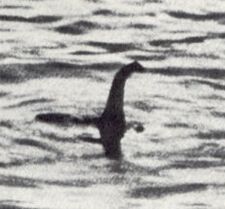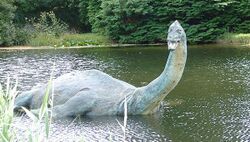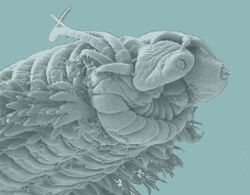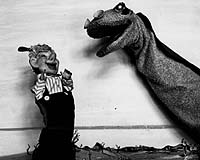Loch Ness Monster
The Loch Ness Monster (nicknamed "Nessie") is a shy vermiform beast supposedly roaming the murky depths of your imagination Scotland's Loch Ness. Since debuting to the world in 565 AD, the monster has made thousands of odd teasing surface appearances, mostly to shaky-handed photographers with poorly-focused cameras, the elderly, drunk Scotsmen, and others of poor judgement or limited vision. Eyewitness accounts and popular culture tend to cast the dreadful beastie as a plesiosaur, making it more appealing to a juvenile audience.[1] The reality of it is far more horrible than most folk are able to stomach; if you wish to see the creature's actual disgusting appearance, ,[2] but don't say I didn't warn you.
Nessie is worth a large fortune to the Scottish tourism industry, and to the economies of Inverness and the Highlands in particular. It should therefore be treated as a fact, not fiction, and all scepticism should be put aside for the greater good of the puir wee bairns. At least believing in it doesn't incur dire consequences, unlike many other things.
History[edit]
Origins[edit]
As the official pamphlet at the Loch Ness Gift Shop™ goes, Nessie was born in the North Sea around 65 million BC. Somehow, she managed to survive the asteroid that hit the Earth and changed the atmosphere thus killing off dinosaurs and numerous other reptiles; how you may ask? We don't know, but don't ask, because it'll spoil the mystery of the Magic in the Water™.
Nessie had incredible genes and managed to long outlast her ancestors, surviving on a steady diet of sea-chocolate, sea-olive oil, and sea-Port wine. Around 30,000 BC, near the beginning of the final ice age, Nessie decided to take a swim in the nearby Great Glen; it was around this time that the glen was frozen over by a huge glacier, trapping the beastie inside. This glacier found the fault easy to erode over, thus creating Loch Ness™ as we know and love it today, and accounting for the loch's incredible of depth of 600ft. below sea level which allows Nessie™ to easily hide from us pesky humans.
Many years later, c. 10,000 BC, Nessie was unfrozen, apparently possessing the strength of immortality, which again can be chalked up to her fabulous genes and diet. She spent the next several thousand years not really doing much in her newly-formed home; sometimes, peasants would let their children play in the loch with the Kelpie because of how cute and playful she seemed, but this stopped when their children began to disappear.
St. Columba[edit]
Nessie's debut to the general public can be traced back to 565 AD. As the story goes, the monster, who was taking a trip to the nearby River Ness, came across a Pict swimming in the river and ate the poor fellow, bitter over not tasting human flesh in thousands of years. Later, a monk named St. Columbo and his sidekick Luigne "Legume" Moccumin, who had been travelling Scotland converting people, swam into the river looking for the Pict's body. Nessie then reappeared and attacked Legume, but Columbo held up a cross and commanded the beast to get lost, and so she did. The Picts praised God for this miracle and crowned St. Columbo their king.
Surgeon's Photograph[edit]

The most famous photograph of the Loch Ness Monster is the "Surgeon's Photo", initially said to be taken in 1934 by Colonel Robert Wilson, a British Army surgeon.[3] Although somewhat convincing in the cropped version, a full-sized version of the photograph later emerged showing that the "head" of the monster was actually remarkably puny. The final blow came in 1994; Christian Spurling, the son-in-law of big game hunter/filmmaker Marmaduke Wetherell, revealed that it was a toy submarine passed off as a monster by his stepdad to exact his revenge on the Daily Mail. Wetherell had been humiliated by his bosses after finding alleged "Nessie footprints" on the shoreline which turned out to be prints from a hippo-foot umbrella stand, and decided that "So they want a monster? Let's give 'em their monster." Wilson, a friend of Wetherell who enjoyed a good practical joke, sold the photos of the "monster" to the Mail, thus creating a worldwide sensation, and the rest is history.
Present day[edit]
Nessie resides in Loch Ness to this day, taking on a more shy and playful attitude in recent sightings — a step up from the bone-crushing monster who preyed upon anyone that invaded her home as she used to be.
Plausability[edit]
“It's a phallic symbol, indicative of a Scotsman's sex drive lurking under the surface threatening to pounce you any minute.”
Descriptions of the monster's appearance vary from one sighting to the next. Based on accounts however, we can piece together that her body is long and hard, extruding curly hair-like fibers at the end. Along the spine of Nessie are large zits, often mistaken for growths. The skin of the monster has been described by eyewitnesses as being an orangey, pink, sickly green, shining jet black, multi-monolithic color; horns have been spotted on the beastie on rare occasions. Accounts of the monster's size vary from as larger as 20 ft. in length, to as larger as 60 ft., to as larger-er as 90 ft. Some witnesses claim it can breathe fire, do magic tricks, or produce long chains of polysaccharides. Others say the monster shows up at odd times demanding £3.50, and spends the mating season on Pluto.[4]
Explanations for what the monster could be include plesiosaurs, long-necked newts, zeuglodons, giant eels, dragons, and aquatic bristleworms, as well as potential misdentifications of birds, elephants sticking their trunks and head-tops out of the water, sturgeon, seals, dolphins, whales, tree branches, standing waves, and boat wakes. Frequent claims that the monster is merely a Highlander trap to lure thick tourists have been disproven, as there are thousands of sightings, not to mention irresistible Nessie plushies from our gift shop. Seriously, there's a whole colony of monsters in Loch Ness that just so happen to rarely emerge from the water, avoid human contact at all times when they do surface, and evade every single precisely-calculated attempt by humans to capture them with baited freshwater salmon.
Attempts at capture[edit]
Local Nessie expert Willie Cameron is such a fearsome red-bearded Scot, that during his frequent TV appearances viewers are convinced that a surviving marine reptile from the Jurassic Period actually exists. Offers by Cameron of a £3.50 million reward to capture the monster are best avoided, as nobody who has accepted this offer has ever been seen again.
Similar beasts[edit]
Jealous of Loch Ness, other Scottish bodies of water have claimed their own cryptids. Morag in Loch Morar has been observed several times over 100 years, notably upending a boat carrying two fishermen in 1969; otters may be responsible. The awesomely-named monster Muc-sheilche lives in Loch Maree. Lochs Arkaig, Awe, Duich, Linnhe, Lochy, Lomond, Oich, Quoich, Shiel, and Suainaval, in addition to being the sounds a Scotsman makes falling down a flight of stairs, also claim beasts. The Stronsay Beast was a decomposing carcass washed ashore in 1808 which looked very slightly like a plesiosaur. Giglioli's Whale, a mutant whale distinguished by a second dorsal fin, has been misidentified in water off Aberdeen.
References[edit]
- ↑ Leaving aside the fact that plesiosaurs were physically incapable of holding their neck in the manner depicted.
- ↑ Extrapolated from F.W. "Ted" Holiday's The Great Orm of Loch Ness (Faber and Faber, 1968).
- ↑ Actually a gynaecologist, but "Gynaecologist's Photo" might get unexpected search results.
- ↑ Beware Scotsmen who offer to "take you to Pluto to meet Nessie" via syringe "mind travel", as the needles could be dirty and you will probably get bummed.
| ||||||||||||||||||||



